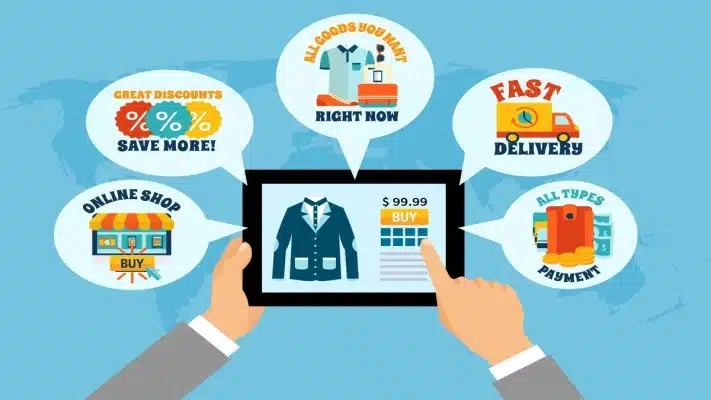What is Social Commerce? It’s Benefits and Popular Platforms

Given that approximately 4.59 billion individuals, constituting 57% of the world’s populace, are presently active on social media platforms, incorporating social commerce into your brand strategy becomes an obvious choice for expanding your brand’s visibility.
Globally, the social commerce market is expected to grow to more than $2 trillion by 2025. This substantial growth is driven by the increasing integration of social media platforms with eCommerce functionalities. With the rising popularity of social commerce and its potential to revolutionize online shopping experiences, businesses are increasingly leveraging this trend to expand their customer reach and boost sales.
If you’re interested in capitalizing on the promising prospects presented by the growing social commerce market, we have you covered. Continue reading to gain insights into the fundamentals of social commerce (sCommerce), enabling you to secure your share of the profits.
Table of Contents
What is Social Commerce?
Social commerce refers to the use of popular social media platforms like Instagram and Facebook for marketing and selling products and services. This innovative selling approach enables customers to finalize their purchases directly within the social media applications as virtual storefronts, without the need to navigate to external websites.
Social commerce is booming because a survey conducted by a leading marketing firm revealed that around 70% of consumers are influenced by social media when making purchasing decisions. Also, Research suggests that approximately 30% of online shoppers are more likely to make a purchase if they can directly buy a product through social media.

Social media platforms like Instagram and Pinterest are particularly popular for product discovery and inspiration. Among the leading social media platforms, Instagram, Facebook, Pinterest, and TikTok stand out with their integrated social commerce capabilities, making them ideal choices for businesses looking to leverage native eCommerce features within social apps.
Social commerce allows customers to discover, share, and purchase products or services directly within their social media feeds, eliminating the need for multiple clicks and redirects. Like you are scrolling Instagram and you spot a well-priced set of EarPods for you or your loved ones, click ‘Shop Now’, complete your purchase, and continue enjoying your Insta feed.
With the increasing popularity of social media platforms such as Facebook, Instagram, Twitter, and Pinterest, businesses now have an unprecedented opportunity to reach millions of potential customers and build a strong online presence. So why not take advantage of these ‘Shopportunities’?
Distinguishing Social Commerce from Ecommerce
Although social commerce is a subset of eCommerce, Social commerce and eCommerce are not the same. Ecommerce refers to online shopping experiences that occur on websites or branded apps. In contrast, social commerce allows customers to research, discover, and make purchases directly within social media platforms.
Facebook, Instagram, Pinterest, and TikTok have evolved into such virtual storefronts by incorporating native selling tools, delivering an effortless shopping experience.
Distinguishing from social commerce, social selling involves nurturing connections on social media to establish a pool of potential sales prospects. Unlike social commerce, which focuses on direct sales, social selling emphasizes relationship-building with the ultimate goal of making future sales. While social selling can occur both offline and online, it predominantly takes place through various social media platforms.
How does Social Commerce Benefit you?
Statistically, around 81% of small and medium-sized businesses utilize social media platforms for their marketing and sales efforts. It is estimated that by 2023, the number of social media users engaging in social commerce activities will surpass 1 billion. So there’s a large piece of the pie to claim for your business.
Other than this potential boost in your eCommerce sales, here are a few more reasons why social commerce deserves a shot.
To Reach Your Target Audience
The world spends more than 10 billion hours every day using social media. The world today has 6.648 billion smartphone users, meaning almost 83.07% of the world’s population owns a smartphone today.
Social media platforms possess a wealth of data about their users, enabling businesses to target their advertising efforts with precision. Additionally, social commerce platforms provide robust remarketing capabilities, allowing businesses to retarget customers who have shown interest in their products or abandoned their shopping carts.

Like your Customized athletic shoes can be beamed right to the feeds of fitness enthusiasts, home decor items and furniture can be targeted to a newlywed couple planning to have a new home. Personalized beauty and skincare products can be recommended to our young consumers.
Social Commerce Provides Frictionless Shopping Experience
Social commerce platforms provide a seamless shopping experience for customers, allowing them to discover, explore, and purchase products without leaving the social media platform. With integrated shopping features such as product tags, shoppable posts, and in-app checkout options, businesses can streamline the purchase process, reducing friction and increasing conversion rates. The convenience and simplicity of social commerce platforms make it easier for customers to make impulse purchases and discover new products, thereby boosting sales for businesses.
Enhanced Customer Trust
Research indicates that social media influences the purchasing decisions of approximately 45% of online shoppers. Trust plays a vital role in driving online sales, and social commerce can help businesses build trust through social validation. When customers see their peers endorsing a product or sharing positive experiences, they are more likely to trust the brand and make a purchase. By actively engaging with customers, addressing concerns, and providing exceptional service, businesses can establish themselves as trustworthy entities in the social commerce landscape.
Increased Customer Engagement
Social commerce enables businesses to interact directly with their customers, offering personalized experiences and addressing their queries and concerns in real time. By actively engaging with customers through comments, messages, and interactive content, businesses can create a sense of community, establish trust, and encourage repeat purchases.
Top Social Commerce Platforms
There are currently five major social platforms that offer social commerce facilities. But as the popularity and revenue of social commerce continue to grow, we’ll be seeing more of these social media brands integrating “BUY NOW” buttons.
Facebook is the most-used platform by marketers worldwide (90%). As of Q4 2022, Facebook is the largest online social network in the world with roughly 2.96 billion monthly active users. An average American spends 33 minutes per day on Facebook.

In 2020, Facebook launched Facebook Shops with the goal of helping small- and medium-sized businesses to create online storefronts. It’s been a huge success and, during a Clubhouse discussion, Mark Zuckerberg revealed that 250 million people interact with it per month. A 2022 Hootsuite report showed that one million Facebook users buy from Shops monthly. Some brands said their sales through Facebook Shop exceeded the sales from their websites by 66%.
What’s more, a survey completed in the middle of 2022 has identified Facebook as the leading social network for shopping in the US. While social commerce is more popular among younger audiences, digital shoppers across all age groups have listed Facebook as their top channel. Almost one out of every five US digital shoppers have stated that they’ve used Facebook for shopping, compared to Instagram which was used by 12% and YouTube by 9%. In terms of time, Facebook users spend nearly 20 hours per month using the Facebook app.
It’s expected that it will remain the top social commerce platform for the next few years at least and online data shared by Statista predicts that by 2025 it will have nearly 70 million shoppers.
So why not use your Facebook page to sell your products and boost sales while you’re there? You can do that by opening a Facebook shop.
By optimizing your Facebook business page with relevant keywords, compelling product descriptions, and visually appealing images, you can significantly boost brand visibility and sales. Additionally, regularly updating your page with fresh content, utilizing Facebook’s advertising features, and encouraging user reviews and recommendations can further strengthen your social commerce presence on the platform.
Potential customers can open up a direct messenger chat with your business for brand questions. For brands venturing into social commerce, they can establish a trial store within Facebook Shops, enabling them to incorporate products, oversee orders, and assess customer satisfaction.
According to the online data shared by Statista predicts that by 2025 Instagram will have about 47 million shoppers. A survey completed in 2022 revealed that Instagram is the second most trusted Social Network for Shopping.
Instagram Shops lets users buy products featured in your photos and videos from anywhere across the app. Just like Facebook, Business profiles can create a customizable storefront page that acts as a curated collection of products for sale. There are several ways by which brands can sell their products using Instagram Shops.

Shopping tags let brands tag their products in their feed posts and Stories. U.S. brands also have the option to highlight products in post captions and bios. Instagram users can browse, save, and purchase products displayed by businesses or tagged by influencers through the dedicated ‘Shop tab’. Or you can create Instagram Ads with Shop tab placements within it. These Ads will appear in user feeds with a ‘Sponsored’ label letting users tap through the storefront. Shop through DMs is a recently introduced feature by Meta where shoppers can ask questions, make purchases and can also track their orders.
Over the last three years, the company has seen global user growth increase at an 11% compound annual growth rate (CAGR).
Users create mood boards, pin places to travel, and, more importantly, discover new products. With 445 million active users(as of SEP 22) every month, Pinterest does offer the option to create “Product Pins” (formerly Buyable Pins) for business accounts.
Given that 89% of Pinterest users are there for shopping inspiration, Pinterest has a lot there for your business.
TikTok
The exponential expansion of this video-sharing platform might deceive individuals into believing that it has served as a social commerce platform for a longer duration than it actually has. However, TikTok users engage with the app for more than just entertainment purposes.

According to TikTok, 47% of its users have purchased something they saw on the app(#TikTokMadeMeBuyIt)
With over 1 billion active users worldwide, TikTok offers immense potential for businesses to promote their products and engage with consumers in a creative and authentic manner. The platform’s short-form video format, combined with its algorithm-driven content discovery, allows brands to showcase their offerings in an entertaining and captivating way. Influencer partnerships and user-generated content further amplify the reach of social commerce campaigns on TikTok.
TikTok Shop introduces a novel shopping functionality that enables merchants, brands, and creators to exhibit and vend their products directly on the TikTok platform. This feature provides three distinct avenues for product sales: in-feed videos, LIVEs, and the product showcase tab.
Snapchat
Snapchat has emerged as a prominent player in the realm of social commerce. With its vast user base and innovative features, Snapchat provides brands with a unique opportunity to engage with their target audience and drive sales. The platform’s integration of Augmented Reality (AR) technology enables businesses to create immersive shopping experiences, allowing users to try on products virtually or visualize how they would look in their surroundings. Snapchat’s Discover and Spotlight sections further facilitate brand discovery and promotion.
The innovative technology of AR allows your customers to see how products will look in their own environment before making a purchase, helping to increase confidence and reduce returns. Get our powerful WooCommerce Product View in AR today if you want to enable the Augmented Reality experience on your WooCommerce store.
WhatsApp social commerce adds a multitude of advantages for marketing and driving sales. WhatsApp fosters strong relationships with your customers by establishing a direct and personalized communication channel. It is an optimal platform for your business to reach the target audience with its large user base and extensive engagement rate.
WhatsApp offers a frictionless and convenient shopping experience where you can share your product catalogues, send payment links, and facilitate secure transactions.
Further to enable WhatsApp automation for notifications and purchases for your WooCommerce Store choose our plugin WooCommerce Purchase via WhatsApp.
What’s the Future of Social Commerce?
Fueled by the influence of Generation Z and millennials, social commerce is anticipated to expand at a rate three times faster than traditional eCommerce, reaching an estimated value of $1.2 trillion by 2025. This exponential growth comes as no surprise to industry experts, considering the immense popularity of the viral hashtag and trend, #TikTokMadeMeBuyIt, which has accumulated an impressive 28.6 billion views encompassing advertisements, influencer content, and reviews.
In summary, social commerce has evolved from being a mere suggestion to a crucial component of sales planning in the eCommerce realm. A well-executed social program can significantly impact a brand’s reputation and customer engagement. It is essential to distinguish between merely participating in social commerce and executing it effectively.
FAQs about Social Commerce
Q1: What exactly is social commerce?
Social commerce refers to the practice of using social media platforms, such as Facebook, Instagram, or TikTok, to facilitate the buying and selling of products and services.
Q2: How can social commerce benefit small businesses?
Social commerce can benefit small businesses by providing a cost-effective platform to reach a broader audience, build brand awareness, and engage with customers directly. It offers an opportunity to compete with larger players on a level playing field and drive sales without significant upfront investments.
Q3: Which social media platforms are ideal for social commerce?
The choice of social media platforms for social commerce depends on your target audience and the nature of your business. Platforms like Facebook, Instagram, Twitter, and Pinterest are popular choices due to their large user bases and robust eCommerce features.
Q4: How can I measure the success of my social commerce efforts?
Metrics such as reach, engagement, conversion rates, and return on advertising spend(ROAS) can help you gauge the success of your social commerce efforts. Analyzing customer feedback and tracking sales attributed to social media campaigns are also crucial indicators of success.
Q5: What are some key privacy considerations in social commerce?
In social commerce, businesses must prioritize user privacy by implementing robust security measures, obtaining proper consent, and complying with data protection regulations. It’s crucial to clearly communicate how customer data is collected, used, and protected to build trust and maintain a positive reputation.




